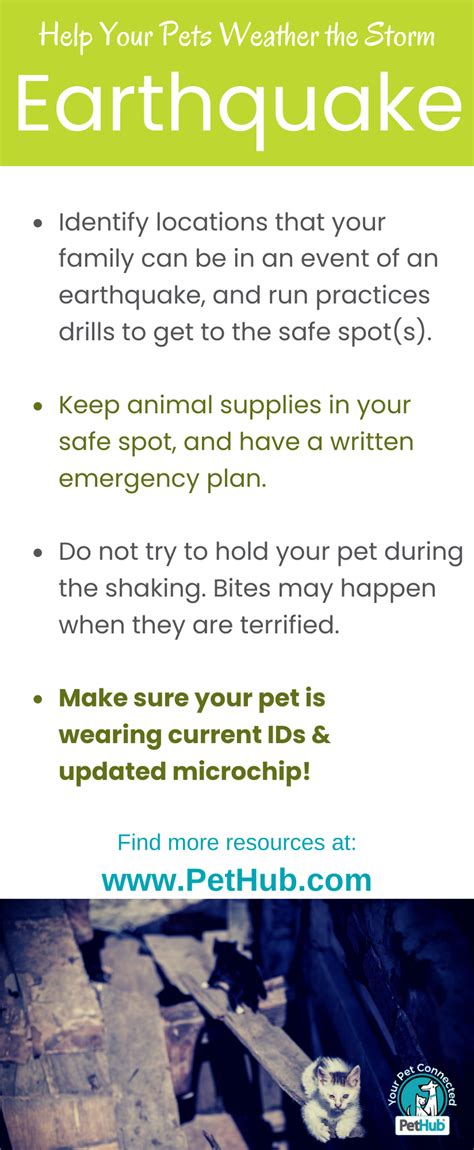Introduction

Earthquakes are a force of nature that can strike without warning, leaving behind a trail of devastation. While human safety is paramount, it’s equally crucial to ensure the well-being of our beloved pets during these emergencies. With the potential for earthquakes increasing in frequency and severity, it’s essential to develop a comprehensive pet emergency preparedness plan that anticipates the needs of our furry companions.
1. Assemble a Pet Emergency Kit
A well-stocked pet emergency kit is a lifeline during earthquakes and other disasters. It should include the following items:
- Food and water: A minimum 3-day supply of non-perishable food and 1 gallon of water per pet per day
- Bowls: Collapsible bowls for food and water
- Medications: Any essential medications your pet requires
- First-aid kit: Basic supplies for treating minor injuries
- Bedding: A blanket or bed for comfort
- Leash or carrier: To restrain your pet for transport
- Toys: To provide comfort and distraction
- Sanitation bags: For waste removal
- Pet medical records: Copies of vaccination and microchip information
2. Secure Pet-Proofing
Earthquakes can cause objects to fall and furniture to shift, creating potential hazards for pets. To minimize risks, consider the following pet-proofing measures:
- Secure heavy objects: Anchor shelves, bookcases, and appliances to walls
- Move breakable items to higher shelves
- Place pet beds and food bowls in safe locations
- Cover sharp corners and edges
3. Identify Safe Zones
In the event of an earthquake, it’s crucial to have a designated safe zone for your pets. This could be a sturdy interior room, such as a bathroom or basement, where they can shelter from falling debris.
4. Establish an Emergency Evacuation Plan
Plan multiple evacuation routes for your home in case of an earthquake. Ensure you have a way to safely evacuate your pets with you if necessary. Consider keeping a pet carrier or leash handy for this purpose.
5. Microchip and Collar Identification
Ensure your pets are microchipped and wear collars with identification tags. This vital information can help locate your pets if they become separated from you during an earthquake.
6. Train Your Pets
Train your pets to respond to basic commands, such as “sit,” “stay,” and “come.” This training can help keep your pets under control during an earthquake and facilitate their evacuation if necessary.
7. Practice Earthquake Drills
Regularly conduct earthquake drills with your pets to familiarize them with the process and reduce their anxiety during an actual event. Practice evacuating with your pets and teach them to stay in their safe zones.
8. Stay Informed and Prepared
Monitor earthquake alerts and warnings, and be prepared to take action if an earthquake is imminent. Have a plan in place to secure your pets and follow your emergency evacuation plan.
FAQs
- How often should I update my pet emergency kit?
-
Every 3-6 months, or whenever your pet’s health or medication changes.
-
What should I do if my pet is injured during an earthquake?
-
Seek veterinary attention immediately. If veterinary care is unavailable, use your pet first-aid kit to provide basic treatment.
-
Can I leave my pet alone during an earthquake?
-
Ideally, no. Pets should be evacuated with their families during an earthquake. If evacuation is not possible, place your pet in a safe zone and secure it as best as you can.
-
What are some common pet health concerns after an earthquake?
-
Shock, lacerations, dehydration, and stress-related illnesses
-
How can I prepare my pet for the emotional impact of an earthquake?
-
Provide plenty of comfort and reassurance, both during and after the earthquake. Consider using calming aids, such as pheromone diffusers or anxiety medication prescribed by a veterinarian.
-
What are some future trends in pet emergency preparedness?
- Smart collars with GPS tracking and emergency alerts
- Emergency shelters specifically designed for pets
- Pet-friendly evacuation plans for cities and communities
Conclusion
Earthquakes are a reality that pet owners must prepare for. By taking the time to implement these simple but effective strategies, we can ensure the safety and well-being of our beloved furry companions during these emergencies. Remember, being prepared not only protects our pets but also brings peace of mind to pet owners, knowing that they have done everything possible to protect their furry family members.
| Item | Quantity |
|---|---|
| Non-perishable food | 3-day supply |
| Water | 1 gallon per pet per day |
| Collapsible bowls | 2 |
| Essential medications | As prescribed |
| First-aid kit | Basic supplies |
| Blanket or bed | 1 per pet |
| Leash or carrier | 1 per pet |
| Toys | 2 per pet |
| Sanitation bags | 20 |
| Pet medical records | Copies |
| Pet-Proofing Measure | Description |
|---|---|
| Anchor heavy objects | Secure shelves, bookcases, and appliances to walls |
| Move breakable items | Place breakable items to higher shelves |
| Place pet beds and food bowls in safe locations | Avoid areas with falling debris |
| Cover sharp corners and edges | Use corner guards or covers |
| Safe Zone | Description |
|---|---|
| Sturdy interior room | Bathroom, basement, or closet |
| Away from windows and falling debris | Interior room with no exterior walls |
| Accessible to pets | Place safe zones near pet beds and feeding areas |
| Emergency Evacuation Plan | Details |
|---|---|
| Multiple evacuation routes | Plan multiple exits in case one is blocked |
| Designated meeting place | Establish a meeting place outside the home |
| Leash or carrier | Secure pets during evacuation |
| Pet emergency kit | Bring pet emergency kit during evacuation |





















